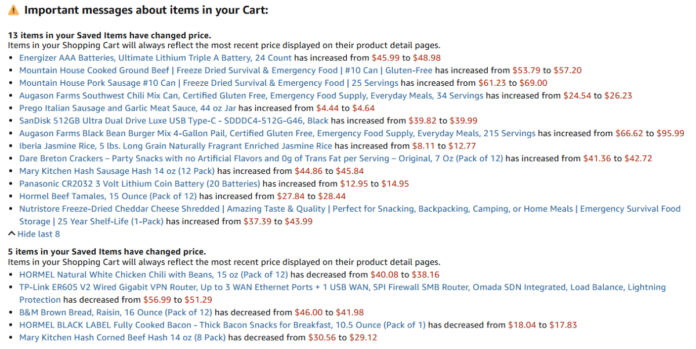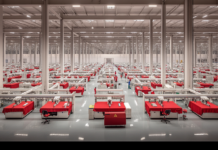
Here’s what I do on Amazon to buy things at their lowest price: I add the item I want to my shopping cart, then I go to my cart and click “Save for Later.” If you are logged in, this moves the item to a “Your Items” list where it stays forever.
When I visit the shopping cart in the future, Amazon gives me a list of what has increased in price and another of what has decreased. Of the 50 items in my list, five to ten usually go up and five to ten usually go down. By monitoring this, I can act when I see a good buy, like a case (12 cans) of B&M Brown Bread with Raisins for just $26.64. The item is currently on sale for $41.98, down from $46, so I saved $15 to $20 by being patient.
Prices change frequently because Amazon uses a process hey call dynamic pricing. That allows a seller of something like the B&M bread to set the price to a range. The seller can price a case of the bread from $26 to $50, for example, and tell Amazon.com to keep their item priced 5 cents less than the closest competitor. As a result, prices are constantly moving about as one seller’s dynamic pricing settings automatically undercuts the other seller’s pricing. When one sells out of the product, the price often rises. If there are no other sellers of this bread, the price will rise all the way to the ceiling of $50.
The clever buyer should try to buy the item when it is near the floor, as I did.
Monitoring Inflation
When I added an item to my cart on Friday, I noticed 13 things had gone up in price and only five had dropped. That was an unusually high ratio of price increases to decreases. Plus, these weren’t moves of just a few pennies. Here are a few examples:
- Energizer AAA batteries were up $3 or 6.5%.
- Mountain House freeze-dried pork sausage was up $7.77 or 12.7 percent.
- Freeze-dried shredded cheddar cheese from Nutristore was up $6.60, or 17.7 percent.
- Augason Farms Black Bean Burger mix increased $29.37 for a 4-gallon bucket, an increase of 44 percent.
- The 20-pack of CR2032 batteries increased $2 or 15.4 percent.
- Jasmine rice was up $4.66, a jump of more than 50 percent.
My initial thinking is these price increases are because of tariffs. And for products made overseas, like the batteries, that is a reasonable conclusion. The rice, for example, is from Thailand, but I believe the cheddar cheese and the pork sausage are made in the U.S. from U.S. ingredients. So why are they charging more? A quick search revealed I can buy empty #10 cans for less than $3 each, so they can’t blame their large a price increases on the cost of the steel can.
For now, I’m just going to monitor the situation and check in maybe every other day to see if those prices come back down or if others also go up.
Update
Two days after writing the above, I checked again, and this time five items had decreased while only two had increased, which improves the ratio of winners and losers. One item that dropped in price was the rice, which sank to $6.48, even lower than the price before the last reported increase. So instead of being up more than 50 percent, it was now down 20 percent. That’s a huge swing in 48 hours.
On the other hand, the Augason Farms black bean burger mixed increased another $4, to $99.99. I have no explanation for that. I don’t know whether to blame tariffs or the algorithm. Or maybe Amazon is to blame since they are the only company selling this item on their site. Without competition from other sellers, they can price it however they want and milk their customers. This just goes to show you, it pays to be careful and compare prices, both on Amazon over time and with other sellers.
Some items in my saved list of items on Amazon are things I may buy one day if the price is right. Others are items I keep in the cart so I can order them in an emergency. Some, like the batteries, are there so it is convenient to find when I need to re-order. It’s a useful feature.
Amazon for Preppers
Despite shopping on Amazon, I am not a huge fan. I prefer to buy from local sellers and often do, but when the price of two Duracell CR2032 batteries at the local hardware store is almost what I pay for 20 Panasonic batteries online, buying the 20 is a no-brainer. If tariffs work as Trump hopes, maybe we’ll be able to buy more products made in the USA from more domestic sellers. In the meantime, I’m going to get the best deal I can for products that are not sold locally. And out here in the middle of nowhere, that’s lots of products.
In my experience, Amazon is not always the best place to get prepping items. For example, during their March sale, I got Mountain House meats in #10 cans from the Mountain House website for 50 percent off the retail price, far less than I have ever seen them on Amazon.
Amazon is also a terrible place to buy firearms related gear because they are liberal enough to not like guns parts that might be for an “assault weapon.” Unfortunately, my favorite local gun store closed, so I often buy from online stores like Optics Planet, Palmetto State Armory, Aim Surplus, Skid Tactical, Brownells, and Midway USA.
For food, I prefer Sam’s Club, Costco, or Walmart, and for long-term storage food I like Rainy Day foods. But I will admit if you need something in a day or two, it is hard to beat Amazon.






